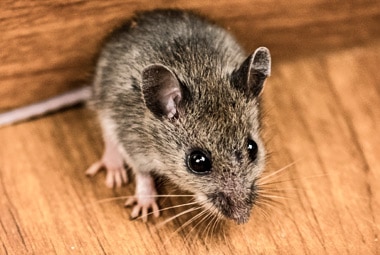
House mice are a type of commensal rodent, which means that they at least partially rely on people for their food, water, and shelter sources. House mice are especially problematic in the fall when the weather becomes cooler and they invade homes searching for a safe place to overwinter in. House mice can damage property, introduce diseases into your home, and contaminate your food sources.
| Pest Identification | |
|---|---|
| Recognition | The house mouse ranges in size from 5-½ to 7 inches in length including the tail. Their fur is gray, brown, or black in color and they have a lighter tan colored belly. Their very large ears and tail are covered in a light layer of velvety fur; house mice have very tiny dark colored eyes. |
| Biology | Before giving birth the female creates a ball-shaped nest out of fibrous materials, the nests are about 4-6 inches in diameter. House mice can breed year-round but mainly breed in the fall and spring. At about 6-10 weeks of age, house mice are sexually mature and can reproduce. They have a gestation period of about 19-21 days and give birth to 4-6 young per litter. Each female can produce 5-10 litters per year. In the wild, house mice have a relatively short lifespan of about 9-12 months, but within that short lifespan, they can produce a lot of young. Mice are known carriers of diseases that can affect people, including Hantavirus, Leptospirosis, and Lymphocytic diseases along with many others. Mice can introduce parasites like fleas, mites, and ticks into your home and their urine can trigger reactions in some people. |
| Habits | House mice have very poor eyesight and instead rely on their other senses- smell, taste, and touch. In addition to living inside of homes, they can be found in fields, lawns, commercial buildings, and on farms. Mice feed on a variety of items including grains, seeds, and foods found inside homes that are high in fat, protein, and sugar. When mice enter homes they nest behind walls, in ceilings, behind large appliances, and in basement and attic areas. Mice can be more than just a nuisance, they can chew through and damage wires, pipes, insulation, and drywall. Mice can also chew on and destroy pictures, furniture, flooring, clothing and other personal items. |
| Prevention | The best prevention against the house mouse is to fix the areas in and around your home that may allow them access inside of it. Seal any openings around your home bigger than ¼” including cracks and crevices in the foundation and gaps around windows and doors, place a tight-fitting cap on all chimneys, make sure vent covers are secure and fix loose or missing roof shingles. It can also be helpful to keep tight-fitting lids on outdoor trash cans, trim back trees and bushes away from the outside of your home, and make sure that food in your kitchen is stored in sealed containers or in the refrigerator. Be sure that spills and crumbs are cleaned up quickly and wash dirty dishes in a timely manner. |
| Professional | Professional control is the best way to eliminate problems with the house mouse and other types of rodents. Rottler’s home pest control and commercial pest management solutions not only control mice but also prevent rodents from re-infesting with exclusion methods. Our trained technicians will inspect and identify areas of rodent infestation and areas that are attracting rodents to your home. Then, we will recommend changes and treat as needed; seal off entry and exit points, and install glue boards, traps and/or secure rodent bait stations in conducive areas. |

